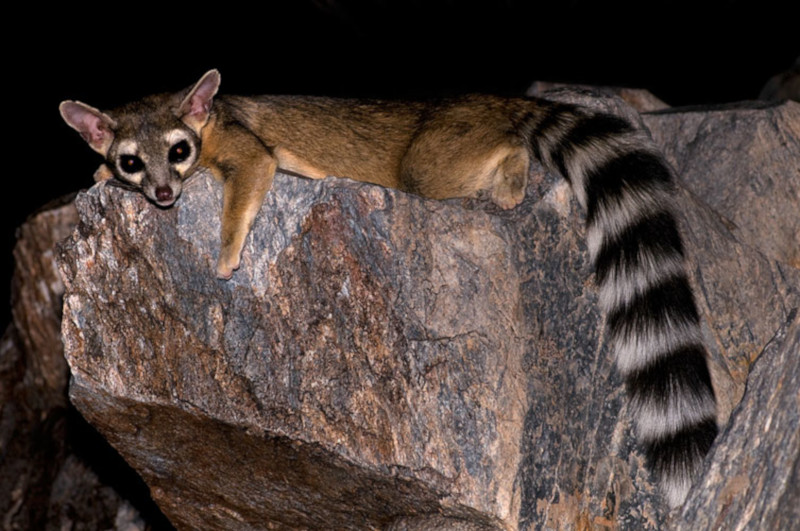
Ring-Tailed Cat Facts
- The descriptive term of Ring-Tailed Cat excellently serves as one of several common names for a remarkable variety of mammal. This distinctive creature does have a few other general titles, though. Those include such terms as the miner’s cat, ringtail cat, and the bassarisk.
- Within the halls of science, however, the marvel’s perhaps better known by its technical designation. Unfortunately, like many formal tags, that’s somewhat difficult for the layperson to pronounce. That’s because the unique animal holds the formal moniker Bassariscus astutus.
- The intriguing animal received that tongue-twisting name due to the efforts of Martin Heinrich Carl Lichtenstein. The respected German zoologist recorded the first official recognition of it as a separate and distinct species. He achieved that scientifically noteworthy feat in 1830.
- The most frequently applied of the general epithets for this fascinating animal’s nonetheless quite deceptive. Despite that title, the creature holds absolutely no relationship to felines. The impressive product of Nature and evolution’s actually as a member of the Raccoon Family.
- Most fortunately, the marvelous animal also presently appears to be maintaining a population base that’s both sufficient and stable. This further seems to hold true throughout the entirety of its native range. The IUCN, therefore, presently lists it as Least Concern on its Red List.
- The remarkable mammal nonetheless must be considered to be facing at least some risks, though. Given mans increasing encroachment on its territory, habitat loss poses a very real threat. Its greatest danger, though, no doubt comes in the form of ongoing climate change.
Related Articles
Ring-Tailed Cat Physical Description
The fabulous Ring-Tailed Cat rarely, if ever, fails to capture the attention and interest of those individuals fortunate enough to encounter one in the wild. The mammal does not typically do so, however, due to any impressive physical dimensions. In fact, it’s actually a diminutive creature.
Where its appearance remains concerned, it also sets itself somewhat apart from many other mammals in one interesting manner. That’s manifested by the fact that this particular creation of evolution displays virtually no detectable degree of the physiological trait of sexual dimorphism.
Among specimens of both sexes, the body of the amazing carnivore displays the same approximate body shape and design. That excludes, of course, the reproductive organs. As a general principle, not including gravid females, it possesses a slender body and the noted comparatively outsized tail.
Mature adults of both genders attain an average total length equaling roughly anywhere between 24 – 32 in (61 – 81 cm). However, in most instances, the tail of this biological marvel accounts for nearly half of that! This characteristic provides the species with a difficult to miss visual appearance.
Weights among examples of this member of its Family, meanwhile, also vary equally widely, completely regardless of gender. As a general principle, though, this typically ranges from 1.5 – 3.3 lb (0.7 – 1.5 kg). These statistics denote a size for it that’s slightly less than the average house cat.
Yet, it’s without doubt the patterns of color the Ring-Tailed Cat displays that usually garner the most attention. Individuals present a yellowish-brown to grayish-brown coat on the back and a pale or whitish underside. The same fur also develops as relatively short, dense, and surprisingly soft.
The previously mentioned tail also grows quite bushy in nature, and displays alternating black and white rings, usually 14 – 16 in number. Its face shows a pointed snout, large rounded ears, and prominent dark eye rings. It legs also develop as short but strong, with sharp, semi-retractable claws.
- Kingdom: Animalia
- Phylum: Chordata
- Class: Mammalia
- Order: Carnivora
- Family: Procyonidae
- Genus: Bassariscus
- Species: B. astutus
Ring-Tailed Cat Distribution, Habitat, and Ecology
This magnificent fauna, the Ring-Tailed Cat, evolved as indigenous to a moderately broad swathe of the surface of the earth. The exact location of that zone of habitation might surprise some of you, though. That’s because its territory covers a large portion of the continent of North America.
The impressively intrepid cousin of the raccoon inhabits a large portion of the country of Mexico. There, it appears throughout much of the country, including Baja California, Sonora, Chihuahua, and further south. No evidence exists of its habitat range reaching into Central America, though.
It’s also found within the confines of the United States, as well. Inside the borders of that country, its present in Oregon, California, and Nevada in the west. From there, it also appears through Arizona, New Mexico, Texas, Utah, Colorado, Oklahoma, and even into some small parts of Kansas.
Within this comparatively extensive habitation zone, though, the animal evolved as highly adaptable. As a result, the resourceful animal inhabits a wide range of habitat types. These include such regions as deserts, semi-arid areas, pine and oak woodlands, conifer forests, and chapparal.
The remarkable creation of Nature also appears within a very broad range of altitudes. Individuals occur at heights of as much as 9,514 ft (2,900 m). Most though, live from sea level to around 4,593 ft (1,400 m) above sea level. It also prefers many areas of canyons, rocky outcroppings, and talus.
Like the previously mentioned cousings, the awesome Ring-Tailed Cat evolved as omnivorous in nature, like related species. Although it does display a decided preference for meat, it also consumes a moderate amount of vegetation. Its prey mainly consists of small animals, such as birds and frogs.
Its own predators, meanwhile, consist of several different species. These include such varied animals as coyotes, actual raccoons, bobcats, owls, and hawks. It does, however, have one means of defense. It evolved a gland that releases a highly pungent musk when threatened, similar to a skunk.
Species Sharing Its Range
Check out our other articles on 4 Amazing North American Deserts, Black-and-white hawk-eagle, Salar de Uyuni, Mary River Turtle, Violet Carpenter Bee, Antarctic Beech, Japanese Hare
